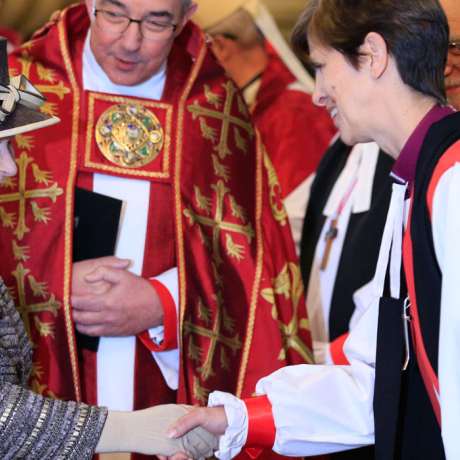The Queen and the Church of England
The Sovereign holds the title 'Defender of the Faith and Supreme Governor of the Church of England'. These titles date back to the reign of King Henry VIII, who was initially granted the title 'Defender of the Faith' in 1521 by Pope Leo X. When Henry VIII renounced the spiritual authority of the Papacy in 1534 he was proclaimed 'supreme head on earth' of the Church of England. This was repealed by Queen Mary I but reinstated during the reign of Queen Elizabeth I, who was proclaimed 'Supreme Governor' of the Church of England.
The Monarch's relationship with the Church of England is symbolised at the Coronation when the Sovereign is anointed by the Archbishop of Canterbury and takes an oath to "maintain and preserve inviolably the settlement of the Church of England, and the doctrine worship, discipline, and government thereof, as by law established in England".
On the advice of the Prime Minister The Queen appoints Archbishops, Bishops and Deans of the Church of England, who then swear an oath of allegiance and pay homage to Her Majesty. Church of England deacons and parish priests also swear an oath of allegiance to the Sovereign.
In spiritual and practical matters the Church of England is led by 108 Bishops and managed by a General Synod, which is elected every five years from the laity and clergy of its 41 dioceses. The Synod meets twice annually in London or York to consider legislation for the good of the Church. The legislation is subject to Parliamentary veto and receives Royal Assent as Acts of Parliament. The General Synod also passes ecclesiastical regulations called Canons. These Canons, which bind the clergy and laity of the Church, are submitted to The Queen for promulgation by Royal Licence on the advice of the Home Secretary. Find out more about the structure of the Church of England on their website.
In 1970 Queen Elizabeth II became the first Sovereign to inaugurate and address the General Synod in person. Since then Her Majesty inaugurated and addressed the opening session of the General Synod every five years after diocesan elections.
The Church of Scotland
Monarchs have sworn to maintain the Church of Scotland since the sixteenth century. The duty to "preserve the settlement of the true Protestant religion as established by the laws made in Scotland" was affirmed in the 1707 Act of Union between England and Scotland.
Queen Elizabeth II made this pledge at the first Privy Council meeting of her reign in February 1952.
The Queen's relationship with the Church of Scotland was symbolised by a Service of Dedication in St. Giles Cathedral in Edinburgh on 24 June 1953, three weeks after the Coronation. During this ceremony Her Majesty was blessed by the Dean of the Chapel Royal in Scotland and the Moderator of the General Assembly of the Church of Scotland.
The Church of Scotland is a Presbyterian church and recognises only Jesus Christ as 'King and Head of the Church'. The King therefore does not hold the title 'Supreme Governor' of the Church of Scotland; when attending Church services in Scotland His Majesty does so as an ordinary member.
The Church of Scotland is entirely self-governing. It is managed on a local level by kirk sessions, at a district level by presbyteries, and at a national level by the General Assembly, which comprises 850 commissioners and meets each May, generally in Edinburgh. Find out more about the government of the Church of Scotland on their website.
The Sovereign is represented at the General Assembly by the Lord High Commissioner, who attends as an observer and is appointed by His Majesty on the advice of the Prime Minister. The Lord High Commissioner makes opening and closing addresses to the General Assembly and reports to His Majesty on its proceedings. Members of the Royal Family have acted as Lord High Commissioners. The Queen, with The Duke of Edinburgh attended and addressed the General Assembly on a number of occasions, most recently in 2002.
The Queen and other faiths
The Queen acknowledged and celebrated religious diversity and tolerance in the UK and the Commonwealth. This was reflected in Her Majesty's Christmas and Commonwealth Day messages, which often address the theme of inter-faith harmony and tolerance.
The Queen and The Duke of Edinburgh met with and hosted the leaders of numerous faiths and denominations and visited many different places of worship in the UK and across the Commonwealth. The leaders of faiths and denominations are regularly invited to major Royal ceremonial events such as Royal weddings and Services of Thanksgiving.
To mark the Diamond Jubilee in 2012 The Queen and The Duke of Edinburgh attended a multi-faith reception at Lambeth Palace, which was hosted by the Archbishop of Canterbury and attended by the leaders of eight other faiths in the UK.
Faith plays a key role in the identity of millions of people, providing not only a system of belief but also a sense of belonging. It can act as a spur for social action. Indeed, religious groups have a proud track record of helping those in the greatest need, including the sick, the elderly, the lonely and the disadvantaged. They remind us of the responsibilities we have beyond ourselves.
The Queen at at an Inter-Faith Reception, Lambeth Palace, 15 February 2012
In 2007 The Queen received members of the Three-Faiths Forum, an organisation dedicated to building understanding and lasting relationships between people of all faiths and beliefs.
On this occasion Her Majesty was presented with the Sternberg Interfaith Gold Medallion. Established in 1986, it is awarded to individuals who have helped promote peace and tolerance between people of different faiths. Previous recipients include Pope John Paul II.



